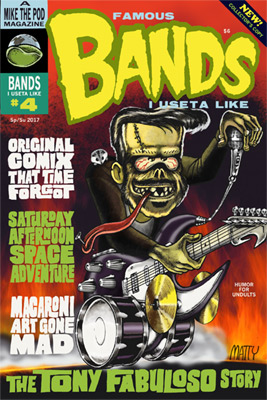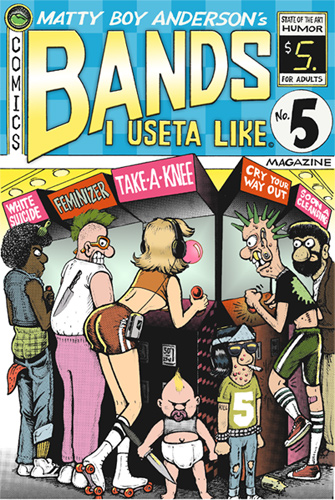That keg tap in the opening panel is drawn from memory. As per my hometown’s tradition, my graduating class (of 135) consumed ninety kegs of beer between January and June of 1990. The number of kegs was determined by the last two digits of your graduating year. I have no idea if the custom continued after the millennium; seems like it would be too easy for the first few decades.
I was embarrassingly poor at the “kegstand”. I think I made it to about 12 seconds; meanwhile, a girl I knew clocked over a minute. I never figured out how to chug beer. I always gulp too much air and I feel like I’m going to die. Being held upside-down above a keg, all I could feel was the blood pounding at the inside of my face. It’s a terrific way to speed up the blackout process, however, or mystify future residents with ceiling footprints.
I saw Bob Marley’s son Ziggy open for the B-52s in concert. Allow me to impart an infallible truism. Talent skips a generation. There is a galaxy of difference between discovering your own creative talent, and passing on that talent to your offspring. That’s why the descendants of artistic geniuses are always spoiled assholes. Their parents’ passion is their burden. They didn’t get to discover a gift naturally; they had a parent pointing the way. Hence, they are never, ever self-reliant, and you get guys like Ziggy Marley. Who stink.
The B-52s were so pure and unique at the start, the world beat a path to their Athens door. John Lennon claimed that “Rock Lobster” was the inspiration for his post-Beatles comeback. In 1981, musical megalomaniac David Byrne butted heads with the B-52s over the production of their third album. Knowing Byrne’s reputation, he probably tried to make them play djembes, or dumbeks, or sing in authentic Mapeyé. Brilliance aside, Byrne writes music like a busted search engine.
Cindy Wilson’s brother Ricky, an original B-52, had the terrible misfortune of contracting HIV in the early 80s, when it was understood by no one. Not only that, but AIDS was formerly known as “GRIDS”, which stood for “Gay-Related Immuno-Deficiency Syndrome”. Before that it was known as “gay cancer”. Ronald Reagan, at the time president of the United States of America, would not say or acknowledge AIDS. Wife Nancy was busy with her “Just Say NO” campaign, beginning a long and fruitless “War On Drugs”. Anal sex and cocaine were subliminally fused in America’s minds, as the government equated them in immorality. Television was, shall we say, overwhelmed with “televangelists”.
When the B-52s were at their peak, it was not uncommon to turn on a television and be subjected to a charlatan bellowing about sin and damnation on a lavishly decorated stage. It was so unavoidable that Frank Zappa dedicated a substantial portion of his 1980s musical output to its derision. He was far from alone; televangelists and their inevitable falls from grace were hot gossip back then. The whores that destroyed them would appear in Penthouse, Hustler, or The Howard Stern Show. Mojo Nixon’s most well-known song, “Elvis Is Everywhere”, featured several passages in a preacher’s patois, and shit, Mick Jagger even attempted it in “The Girl With Faraway Eyes”!
My point is, televangelism, and by extension, Christianity, were on television as often as just about anything else in the 1980s. Preachers railed against He-Man’s “Masters Of The Universe”, because only God is the Master of the Universe. They told nervous mothers that their sons were actually worshiping Satan when they played Dungeons & Dragons. Rev. Donald Wildmon, his generation’s Jack Thompson, saw Mighty Mouse aggressively sniffing a flower, and proclaimed that the pint-size hero was snorting cocaine. It always goes back to cocaine and ass sex with these people. That’s their bread and butter.
So imagine being a great young band from a fun little Georgia town, and suddenly you lose a member and friend, and before you can even work out the reasons why, the world is looking sideways at you. Suddenly Fred Schneider’s John Waters-lite routine is treated suspiciously by radio stations, like they think he’s a wrongful stereotype.
This is how the media treats love, folks.
Here’s the deal: the B-52s are a group of regular Athenians with exemplary taste and talent, with a love for what they do. When I was in high school, my friends joked that I was part of the “Deadbeat Club”, because it began with “what? Get a job?”
I’ve never been to Torchy’s, if it’s still there, but I’ve been to Nuci’s Space, where I saw Vic Chesnutt sing “Tracks Of My Tears”. The sight of that man’s face as he sang the chorus to that classic song is permanently etched into my memory. Nothing can ever uproot that.
No one else can harmonize like Cindy Wilson and Kate Pierson did. No one even sounded like them before the B-52s came around. Kate Pierson guested on Iggy Pop’s “Candy”, and goddamn, her voice is about the most beautiful thing in the universe.
The legendary Charles Burns provided the art for Brick By Brick. I was just discovering Burns’ art in RAW at the time. What a maelstrom of brilliance.
I can’t properly describe the beauty of Kate Pierson and Cindy Wilson’s vocals in the B-52s. Their voices are exalting. They harmonize in a manner long forgotten by pop musicians. Have you ever encountered a person who disliked “Roam”? Because I haven’t. What possible negative could be levied against that song? It’s the most gorgeous piece of music the B-52s ever created. It’s flawless. The girls’ vocals are incomparable. Their singing brings tears to my eyes.
Can you even imagine opening your mouth, and that sound coming out? You can hear the smile and love in their voice. Holy mother of god.
This is the beauty they closed out Cosmic Thing with. See if you can only listen to it once:
Early on, the B-52s would do a guys/girls “call and response” routine, as in “Planet Claire”, and later on in “Love Shack”. “Rock Lobster” would’ve been nothing without Fred Schneider’s weirdo vocals. It’s no accident that Charles Burns’ art graced that Iggy Pop cover, as he inhabited the very same bizarro 1950s headspace as the B-52s. (Seek out Burns’ excellent Pixie Meat with Tom DeHaven, in Glenn Head’s first Snake Eyes, for the keystone of the whole puzzle.) Kate and Cindy had such an innate sense of monster-movie creepiness, “Rock Lobster” went on to define that sensation.
The B-52s were never the same after Ricky Wilson died; he was as much a part of their weirdo DNA as Cindy. When they returned from grieving, the result at first was strong (Cosmic Thing), then progressively weaker (Good Stuff). This doesn’t change or diminish their greatness.
I don’t like to admit how often I’ve thought about banging Kate Pierson, Cindy Wilson, or both.











You must be logged in to post a comment.